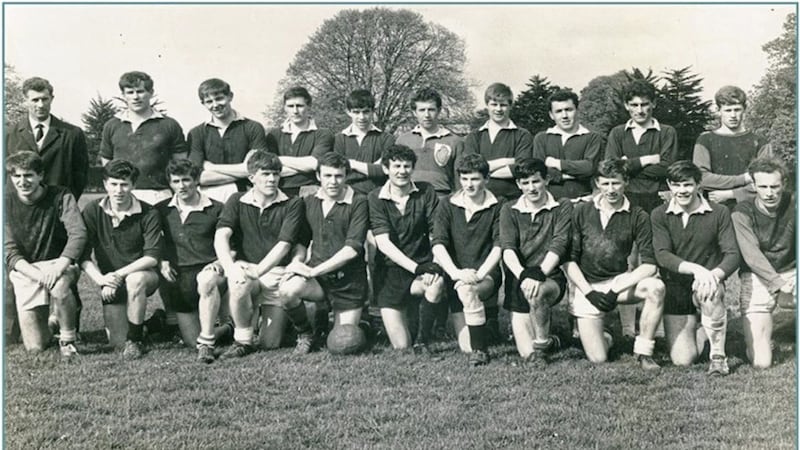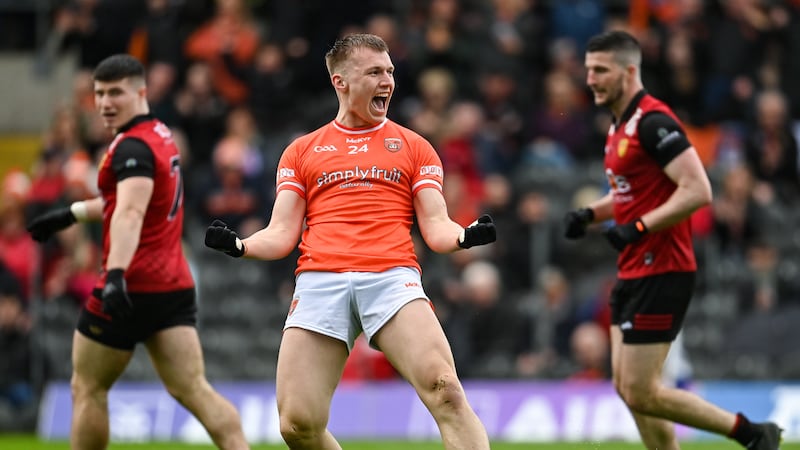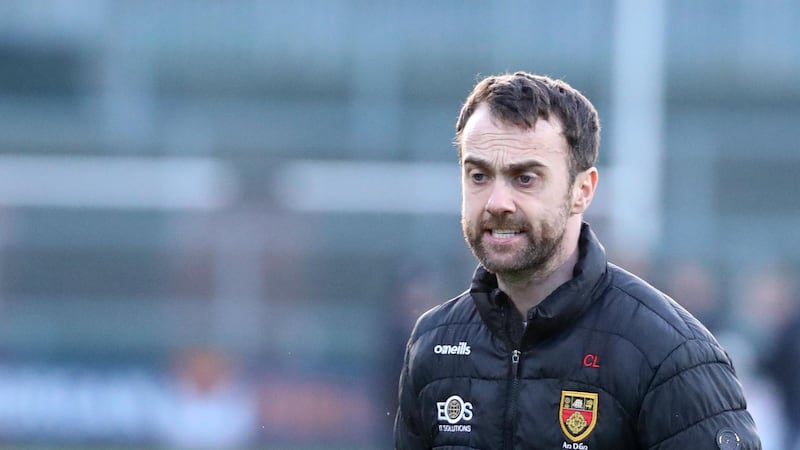IN 1965, St Joseph’s teacher training college had an influx of brilliant young players.
Antrim had won an Ulster minor title in ’64, Derry had won a minor All-Ireland in ’65, St Columb’s had won a Hogan Cup, and the great Down team was at its peak. St Joseph’s drew its men largely from those four, with a few other sprinklings.
This was ‘The Ranch’ before it amalgamated and became known by its current title, St Mary’s.
Under the wing of Derry legend Jim McKeever, they built a team that in the 1967/68 year beat UCD early in the season. They were unbeaten in the few games they played.
It was a team of huge names – Colm McAlarney, Malachy McAfee, Peter Stevenson, Pat King, Matt Trolan, et al.
Yet UCD’s Benny Gaughan would still be the man lifting the Sigerson Cup later in the year, scoring 1-7 in the final. The Dublin college who boarded the plane for an all-expenses paid trip to America laid on by Central Council as a reward.
St Joseph’s weren’t allowed to compete. They established themselves as one of the top teams in the country. But they were all dressed up with nowhere to go.
Trinity had been accepted five years previous. Until that point, the Sigerson Cup was still the preserve of UCD (Dublin), UCC (Cork), UCG (Galway) and Queen’s.
Antrim county board allowed Joseph’s, as they were known, to participate in club leagues but it was a complicated measure, primarily for the fact that players had to leave their home clubs and transfer to the university team.
Their secretary, Gerry Regan, had won a Sigerson at full-back for Queen’s before deciding to pursue teaching. He fought the boardroom battle down the road in Croke Park.
Regan was told that putting St Joseph’s into the Sigerson Cup would ‘be like putting Queen’s into the boat race’.
Blockade after blockade stood in their way. So in an unusual bid to force the GAA’s hand, they decided to turn their hand at rugby.
Paddy Diamond had been schooled at Ballymena Academy. A few others had gone to the Rainey in Magherafelt, the only rugby-playing school in south Derry.
The rest knew little about it, but gave it a rattle anyway.
‘Footballers crossed the Rubicon’ read one newspaper headline from February 1968. Another screamed ‘Switch to rugby at Trench House!’, telling the tale of how this team of Gaelic footballers had recently become affiliated to the Ulster Branch of the IRFU.
“I don’t see what all the fuss is about,” said Artie O’Neill, then the rugby club secretary and a GAA stalwart in McKeever’s native Ballymaguigan.
“One would think from all the talk the college had forsaken the Gaelic code for rugby. Nothing could be further from the truth. Out of approximately 350 students there are only 28 playing rugby… I don’t hear much comment on the soccer team that has been going here for years,” he said.
In word, they played it down. But their actions had caught the GAA’s eye.
The association didn’t really want the college playing in the Sigerson Cup, but they wanted St Joseph’s to become a rugby college even less.
Irish international Syd Millar would come in and coach the rookies their new trade. They played as many games as they could, including trips to Leeds and Manchester.
Rule 27 was a worry for some big-name county players putting their necks on the line.
Paddy Diamond knew he was running the gauntlet but didn’t actually expect that the GAA would go as far as to suspend him.
The unspoken moratorium on school and third-level players being banned gave the false hope that St Joseph’s was a safehouse from The Ban.
Suspend him the GAA did.
The Portglenone midfielder was given six months and, as it turned out, it would effectively end his Antrim career at the tender age of 21.
“I didn’t really fight it. You were never gonna beat them in an appeal anyway.
“What I have always said was there was no prejudice against the college or me. That was the view of a lot of well-intentioned GAA people at the time. That’s what they believed in and they were carrying out the rules.
“Alright, it had to change. But Antrim would have been fairly staunch in that.”
New York didn’t abide by Central Council bans at that time and he travelled out for the summer of ‘68 to the only place he was free to play ball.
He played for Antrim in 1969 before going back to America, where he would stay for a decade.
Diamond joined up with New York’s football team and they would play All-Ireland champions Kerry later that year in the World Football Championship.
Him playing for his county, as well as Mickey Niblock playing for Derry, earlier in the same season led to an eligibility row.
It was quickly sorted when New York sent a telegram to Central Council saying that they “wouldn’t leave Manhattan unless Diamond and Niblock could play”.
Diamond played football for New York for years, alongside another great natural rugby talent in Frank McGuigan, who played for three years at the Rainey.
By the time they both returned to Ireland, The Ban had been abolished and so had rugby at St Joseph’s.
Jim McKeever spoke out against The Ban in the late 1960s, saying it had become ‘impractical and pointless, and that it achieved no good in this day’.
He was a firm GAA man and stayed quietly out of the way of the rugby setup.
“A friend of mine Mickey Madden in Portglenone, father of Kevin, said to me one time: ‘There’s an awful lot of good footballers went to the Ranch’. I said: ‘No, that’s not right. An awful lot of good footballers came out of the Ranch. There was a reason for it,” says Diamond.
Jim McKeever was that reason.
The rugby was a means to an end. An enjoyable one, all the same.
“We would have been out in the gym with the mats, getting guys to run and showing them how to tackle. It was some craic,” recalls Diamond.
“We had to protect the big names. I’ll not mention any of them now, but their names or photos never appeared. The statute of limitation would have kicked in by now, I would have thought,” he smiles.
The whole venture only lasted a couple of years, but that was plenty.
At that stage, it was still only Queen’s representing the north along with the original big three, UCD, UCC and UCG, and relative new-boys Trinity College, who were allowed to enter in 1963.
The GAA externally stood up to the move by banning Diamond for six months, found guilty of the charge of ‘promoting rugby’. But internally, they caved to the pressure.
By the time students returned for the 1969/70 academic year, a new competition had been formed. The Ryan Cup would comprise 12 teams and draw in the colleges who hadn’t been accepted into the Sigerson Cup.
It gave St Joseph’s a foothold. It gave them games.
“The GAA footballers in the Ranch will never know whether the rugby club was a mere distraction or a powerful catalyst that would change fixtures in the academic year in the years ahead – which it did,” says Diamond.
“The GAA would have been concerned by so many playing rugby and they wanted to come up with something.”
The college amalgamated and became St Mary’s. They were eventually inducted in 1988 alongside Thomond College and NIHE Limerick as part of the latest tranche.
The Ranch, as they’d become known, would win their first Sigerson the following year with a star-studded team of future All-Ireland winners.
In that time Paddy Diamond had been to America, lived it and come back to settle in Randalstown with his wife Sally and their four children.
In some ways, he was a sacrificial lamb.
Creating a rugby team opened the door for what they’d originally wanted to achieve, a set routine of Gaelic football matches that the college could compete in.
St Mary’s would go on to establish itself as an institute of Gaelic football in the heart of west Belfast, winning their remarkable second Sigerson Cup four years ago.
Though it became largely of his own choice, the price to Antrim football of losing Paddy Diamond might never have been paid had his suspension not driven him to New York in search of sport.
St Joseph’s, and then St Mary’s, have had a home in colleges football ever since.








